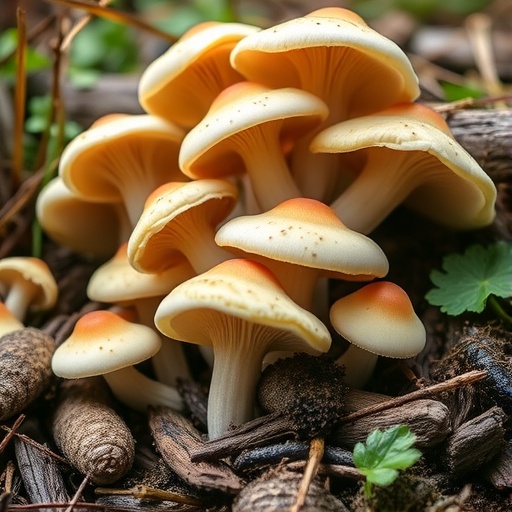In a groundbreaking exploration of sustainable waste management, researchers have unveiled the promising capabilities of bioremediation through the cultivation of oyster mushrooms, specifically Pleurotus ostreatus. This innovative study focuses on the sustainable treatment of landfill leachate, a toxic byproduct of waste decomposition that poses significant environmental hazards. As landfills reach capacity and pollution remains a critical concern, the search for effective and eco-friendly waste treatment solutions has become paramount. With this research, the spotlight is on leveraging agricultural waste to support the growth of oyster mushrooms, which are known for their capacity to break down harmful compounds.
Landfill leachate is created when rainwater filters through waste materials, potentially leaching harmful contaminants such as heavy metals, organics, and pathogens. Traditional treatment methods often involve costly chemical processes or energy-intensive techniques that can lead to secondary pollution. This research takes a novel approach by utilizing bioremediation through fungal metabolism, where the oyster mushroom strains break down complex organic matter and assimilate various nutrients from uncontaminated substrates, converting pollutants into less harmful forms.
The cultivation of Pleurotus ostreatus on various agro-industrial wastes serves as a dual-purpose strategy: it not only addresses waste management challenges but also promotes the circular economy by repurposing agricultural byproducts. The researchers conducted experiments using different substrate combinations, including rice straw and sawdust, assessing their effectiveness in promoting mushroom growth and subsequent leachate treatment. The preliminary findings suggest that certain substrate combinations significantly enhance the bioremedial potential of the mushrooms while also providing a nutritious environment for robust fungal development.
In laboratory settings, the efficiency of Pleurotus ostreatus in degrading organic pollutants was meticulously evaluated. Various leachate samples containing differing concentrations of contaminants were treated with mushroom cultures. Results revealed a striking reduction in chemical oxygen demand (COD), an indicator of organic pollution. Additionally, the experiment highlighted the removal of pathogenic microbes, showcasing the mushrooms’ dual role in mitigating both chemical and biological contaminants often found in landfill leachate.
The implications of these findings are substantial, especially for regions heavily burdened by waste management challenges. By employing bioremediation as a cost-effective and environmentally friendly alternative, municipalities could significantly reduce the ecological footprint of landfills. By promoting the growth of oyster mushrooms, not only is landfill leachate effectively treated, but new avenues for agricultural productivity and food security are also explored.
The study also opens doors for further research into optimizing the substrate-mushroom combination for maximum treatment efficiency. Adjustments in moisture content, nutrient availability, and aeration during the mushroom cultivation process may enhance the bioremedial capabilities even further. This intricate understanding of mushroom physiology could lead to innovative cultivation techniques that align with local agricultural practices and waste management strategies.
As public awareness of climate change and ecological sustainability grows, the outcomes of this research align with global efforts to develop green technologies. Bioremediation represents a harmonious union between nature and technology, demonstrating that solutions to environmental challenges can arise from harnessing natural processes. The study’s findings advocate for widespread adoption of biotechnological approaches within waste management frameworks.
Fungal species, including Pleurotus ostreatus, have long been revered for their ecological benefits, particularly in natural ecosystems where they facilitate the decomposition of organic matter. This research contributes to the burgeoning field of mycoremediation—using fungi for environmental restoration. The evolution of this field suggests an expansion beyond the realm of leachate treatment and into broader applications of fungal bioremediation across varied waste types.
Moreover, the research team emphasizes the potential for mushroom-based solutions to create jobs within local communities, promoting sustainable agricultural practices while empowering individuals to become stewards of their environment. By experimenting with various processes and disseminating knowledge, the practical application of such techniques can lead to enhanced community resilience against ecological degradation and food insecurity.
Overall, the advancement of bioremediation through Pleurotus ostreatus serves as a clarion call for rethinking waste management. As the global population continues to grow and food security remains at the forefront of sustainability dialogues, integrating mushroom cultivation into waste management solutions may shift the paradigm towards more sustainable practices. Ultimately, the promise of this innovative research could pave the way for a future where waste becomes a resource rather than a liability, further bridging the gaps between food systems, climate action, and community wellbeing.
In consideration of environmental preservation and sustainable development, this research captures an essential narrative of hope and innovation. By focusing efforts on leveraging natural biological processes, it brings forth a holistic approach to tackling some of humanity’s most pressing environmental challenges. Through further studies and community engagement, bioremediation could become a cornerstone in achieving a balanced ecosystem, highlighting the importance of collaboration between nature, science, and society.
In conclusion, as we face the limitations of traditional waste management practices, the exploration of sustainable avenues like bioremediation offers promising solutions. The intersection of agro-wastes and fungus cultivation not only makes sense ecologically but also presents economic opportunities within communities. As this research reaches completion, the practical applications and broader impacts will undoubtedly resonate within environmental science and policy discourse, leading towards a harmonious future where human activities align with the natural world.
Subject of Research: Bioremediation potential of oyster mushrooms for landfill leachate treatment.
Article Title: Exploring bioremediation potential: sustainable treatment of landfill leachate with oyster mushroom (Pleurotus ostreatus) grown on different agro-industrial waste.
Article References:
Koudadje, D., Sackey, L.N.A., Yeboah, C. et al. Exploring bioremediation potential: sustainable treatment of landfill leachate with oyster mushroom (Pleurotus ostreatus) grown on different agro-industrial waste.
Environ Monit Assess 197, 1061 (2025). https://doi.org/10.1007/s10661-025-14487-4
Image Credits: AI Generated
DOI: 10.1007/s10661-025-14487-4
Keywords: Bioremediation, landfill leachate, oyster mushroom, Pleurotus ostreatus, agro-industrial waste, sustainable treatment, environmental science.




